Loss of TIMP3 enhances interstitial nephritis and fibrosis
- PMID: 19406980
- PMCID: PMC2689897
- DOI: 10.1681/ASN.2008050492
Loss of TIMP3 enhances interstitial nephritis and fibrosis
Abstract
The balance of matrix metalloproteinases (MMPs) and tissue inhibitors of matrix metalloproteinases (TIMPs) determines the integrity of the extracellular matrix. TIMP3 is the most highly expressed tissue inhibitor of metalloproteinase (TIMP) in the kidney, but its function in renal disease is incompletely understood. In this study, TIMP3-/- mice demonstrated an age-dependent chronic tubulointerstitial fibrosis. After unilateral ureteral obstruction (UUO), young TIMP3-/- mice exhibited increased renal injury (tubular atrophy, cortical and medullary thinning, and vascular damage) compared with wild-type mice. In addition, TIMP3-/- mice had greater interstitial fibrosis; increased synthesis and deposition of type I collagen; increased activation of fibroblasts; enhanced apoptosis; and greater activation of MMP2, but not MMP9, after UUO. TIMP3 deficiency also led to accelerated processing of TNFalpha, demonstrated by significantly higher TACE activity and greater soluble TNFalpha levels by 3 d after UUO. The additional deletion of TNFalpha markedly reduced inflammation, apoptosis, and induction of a number of MMPs. Moreover, inhibition of MMPs in TIMP3-/-/TNFalpha-/- mice further abrogated postobstructive injury and prevented tubulointerestitial fibrosis. In humans, TIMP3 expression increased in the renal arteries and proximal tubules of subjects with diabetic nephropathy or chronic allograft nephropathy. Taken together, these results provide evidence that TIMP3 is an important mediator of kidney injury, and regulating its activity may have therapeutic benefit for patients with kidney disease.
Figures


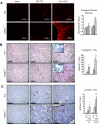
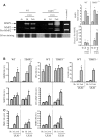
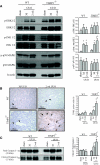
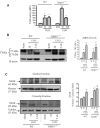

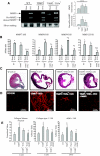

Similar articles
-
TIMP2 and TIMP3 have divergent roles in early renal tubulointerstitial injury.Kidney Int. 2014 Jan;85(1):82-93. doi: 10.1038/ki.2013.225. Epub 2013 Jun 12. Kidney Int. 2014. PMID: 23760282
-
[Significance of imbalance between matrix metalloproteinases and tissue type inhibitor of metalloproteinases in renal tubulointerstitial lesions of aging rats].Zhonghua Yi Xue Za Zhi. 2004 Jun 2;84(11):937-42. Zhonghua Yi Xue Za Zhi. 2004. PMID: 15329283 Chinese.
-
TIMP3 is the primary TIMP to regulate agonist-induced vascular remodelling and hypertension.Cardiovasc Res. 2013 Jun 1;98(3):360-71. doi: 10.1093/cvr/cvt067. Epub 2013 Mar 21. Cardiovasc Res. 2013. PMID: 23524300
-
Matrix metalloproteinases and tissue inhibitors of matrix metalloproteinases in kidney disease.Adv Clin Chem. 2021;105:141-212. doi: 10.1016/bs.acc.2021.02.003. Epub 2021 Mar 9. Adv Clin Chem. 2021. PMID: 34809827 Review.
-
TIMP3 involvement and potentiality in the diagnosis, prognosis and treatment of diabetic nephropathy.Acta Diabetol. 2021 Dec;58(12):1587-1594. doi: 10.1007/s00592-021-01766-y. Epub 2021 Jun 28. Acta Diabetol. 2021. PMID: 34181080 Free PMC article. Review.
Cited by
-
Rethinking glomerular basement membrane thickening in diabetic nephropathy: adaptive or pathogenic?Am J Physiol Renal Physiol. 2016 Nov 1;311(5):F831-F843. doi: 10.1152/ajprenal.00313.2016. Epub 2016 Aug 31. Am J Physiol Renal Physiol. 2016. PMID: 27582102 Free PMC article. Review.
-
The Diverse Roles of TIMP-3: Insights into Degenerative Diseases of the Senescent Retina and Brain.Cells. 2019 Dec 21;9(1):39. doi: 10.3390/cells9010039. Cells. 2019. PMID: 31877820 Free PMC article. Review.
-
Targeting hepatic miR-221/222 for therapeutic intervention of nonalcoholic steatohepatitis in mice.EBioMedicine. 2018 Nov;37:307-321. doi: 10.1016/j.ebiom.2018.09.051. Epub 2018 Oct 10. EBioMedicine. 2018. PMID: 30316865 Free PMC article.
-
Characterization of angiotensin-converting enzyme 2 ectodomain shedding from mouse proximal tubular cells.PLoS One. 2014 Jan 15;9(1):e85958. doi: 10.1371/journal.pone.0085958. eCollection 2014. PLoS One. 2014. PMID: 24454948 Free PMC article.
-
Matrix Metalloproteinases in Diabetic Kidney Disease.J Clin Med. 2020 Feb 8;9(2):472. doi: 10.3390/jcm9020472. J Clin Med. 2020. PMID: 32046355 Free PMC article. Review.
References
-
- Remuzzi G, Bertani T: Pathophysiology of progressive nephropathies. N Engl J Med 339: 1448–1456, 1998 - PubMed
-
- Eddy AA: Molecular basis of renal fibrosis. Pediatr Nephrol 15: 290–301, 2000 - PubMed
-
- Moe OW: Kidney stones: Pathophysiology and medical management. Lancet 367: 333–344, 2006 - PubMed
-
- Nuttall RK, Sampieri CL, Pennington CJ, Gill SE, Schultz GA, Edwards DR: Expression analysis of the entire MMP and TIMP gene families during mouse tissue development. FEBS Lett 563: 129–134, 2004 - PubMed
Publication types
MeSH terms
Substances
Grants and funding
LinkOut - more resources
Full Text Sources
Other Literature Sources
Molecular Biology Databases
Research Materials
Miscellaneous

